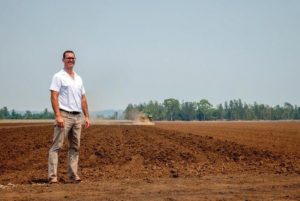Aaron Pollack, CEO of Golden Grove Naturals April 29, 2020
The Top Three Questions That Will Affect The Future Of Australian Farming
Interview with Aaron Pollack, CEO of Golden Grove Naturals
Eddie Bulliqi [EB]: As a farmer, are you fully satisfied with what Australia’s soil profile offers you? Is there anything you wish you could change?
 Aaron Pollack [AP]: The character of the soils reflects the arid and severely weathered nature of the Australian landscape. A distinctive feature would be the naturally low level of phosphorus, due to weathering. Native Australian plants have adapted to low phosphorus soils; many do not need high levels to survive. There is a minority of Australian plant species which are extremely sensitive to excessive phosphorus, and great care should be taken when farming such. Introduced crops to Australia require phosphorus fertiliser to be applied.
Aaron Pollack [AP]: The character of the soils reflects the arid and severely weathered nature of the Australian landscape. A distinctive feature would be the naturally low level of phosphorus, due to weathering. Native Australian plants have adapted to low phosphorus soils; many do not need high levels to survive. There is a minority of Australian plant species which are extremely sensitive to excessive phosphorus, and great care should be taken when farming such. Introduced crops to Australia require phosphorus fertiliser to be applied.
Golden Grove Naturals actively undertakes soil, plant and water testing to monitor and adjust our inputs as required. Over supply of resources can be as detrimental to the farming operations as under supply can be. Maintaining a balance is the key. We are committed to understanding soil microbes which are vital for ecosystem health and supporting soil fertility. Soil fertility and structure is considered a main priority to our farming operations. Healthy soil = healthy plants, and heathy plants lead to regular high quality products and long-term viability and profitability for the business.
Implementing regenerative farming practices is key to our agronomy operations, this includes the rehabilitation of the local environment we operate. These farming practices among other benefits include rebuilding soil organic matter and restoring degraded soil biodiversity. Resulting in both carbon draw down and improving water cycle. Setting up the conditions for crops to become more disease and pest resilient.
EB: Does current government policy and practice support the security of your business? Is there anything more that could be done?
AP: Australia has a “clean and green” image and the government has a commitment to strict quarantine practices and ensuring farmers maintain excellence in low chemical residue status, as well as monitoring the levels of land clearing and licensed water usage; although this seems to be the extent of government policy.
Given the growing sophistication of the international marketplace, consumers are demanding credible evidence to support claims such as clean and green. This may lead to the adoption of integrated quality assurance and environmental management systems, where Quality System provides a guarantee on the quality, clean and safety aspects of the product and process while the Environmental System addresses the “green” component – the impact on the environment.
Government policy could / should provide a framework that is more conducive to better environmental management. Policies focusing on educating the general public about the state of the environment, protecting consumers from misleading claims, developing incentive schemes that reward good agricultural management and penalise noncompliance, providing more funding for research and implementation of practical sustainability indicators are the way forward.
EB: Do you feel connected to the innovation landscape in agricultural science and empowered and capable to invest in and implement new technology? Which technologies and agronomy discoveries most excite you for the future?
AP: Golden Grove Naturals is connected to the innovation landscape and maintains involvement with government and private R&D organisations. I want us to strive to be at the forefront of implementing new technologies, particularly in the areas of reducing reliance on agrochemicals for weed and pest management.
Some examples, I am currently interested in the development, implementation and science behind:
- Soft chemical use in weed reduction, the continuation of substituting agrochemicals for steam to manage weeds in crops, as well as the implementation of unmanned robotics to selectively target weeds for eradication by high pressure / temperature-regulated steam or by mechanical cultivation.
- The implementation of drones to undertake precision pest and plant disease identification and treatments.
- “Live” and in-real-time soil health and structure monitoring equipment and similar for water systems, reading and regulating:
- Moisture meters
- pH meters
- Temperature meters
- Conductivity meters
- Coupling these meters to weather monitoring systems for data logging.
 Ultra International B.V.
Ultra International B.V.